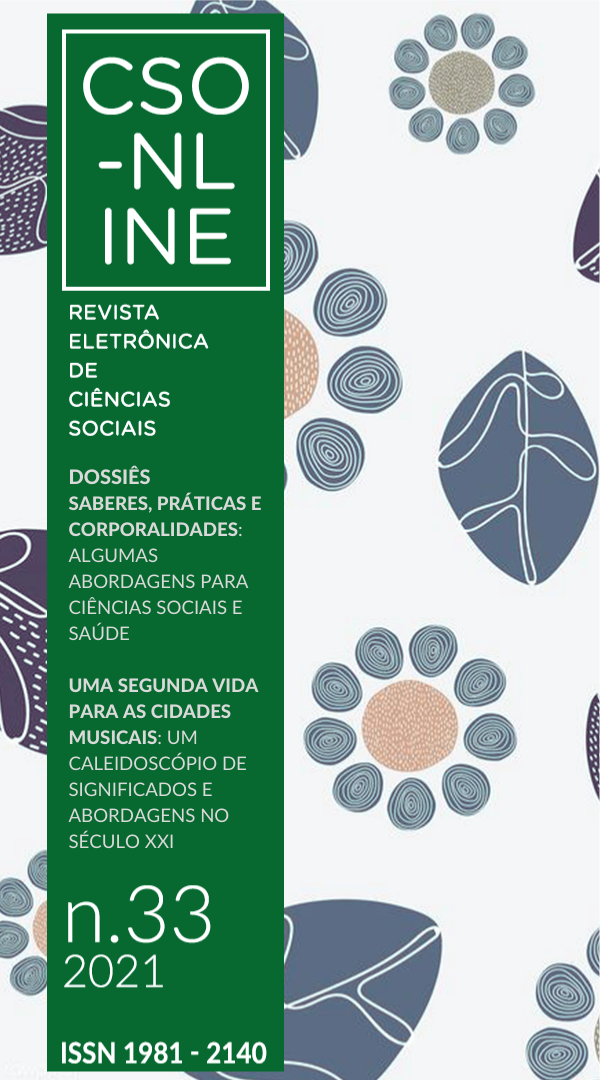Música periférica
estética, cultura e política na cena em Macapá-AP
DOI:
https://doi.org/10.34019/1981-2140.2021.34215Palavras-chave:
Música Periférica, Rap, AmapáResumo
Na contemporaneidade, principalmente para os artistas dos circuitos independentes, a internet se tornou uma ferramenta fecunda para a divulgação de suas músicas, bem como para demarcar seu espaço e propor estratégias para se inserir na cena musical, em Macapá-AP. O cenário musical amapaense é atravessado por múltiplos códigos culturais, sociais e políticos, que representam as particularidades de se produzir e fazer música no contexto amazônico. Tendo como enfoque central o rap, o elemento musical da cultura Hip Hop, este artigo tem como objetivo geral analisar qual o lugar que o rap pretende alcançar no cenário artístico e cultural amapaense. Para tal, adotou-se como metodologia a pesquisa documental e a técnica de entrevista como instrumento para coleta de dados. Como resultado, depreendeu-se que o lugar cobiçado pelo rap é o seu reconhecimento como gênero musical e ativismo social, propondo, através da “Nova MPA”, uma nova categoria musical e cultural para o universo do rap, a Música Periférica Amapaense, aplicado como um meio de expressar sua musicalidade, inconformismo social e o embate para se inserir no cenário musical local.
Downloads
Referências
ALVES, Adjair. Treinando a observação participante: juventude, linguagem e cotidiano. Recife: Editora Universitária UFPE, 2011.
CANCLINI, Néstor García. Culturas Híbridas: Estratégias para Entrar e Sair da Modernidade. São Paulo: Edusp, 2008.
CAMARGOS, Roberto. Rap e Política: percepções da vida social brasileira. São Paulo: Boitempo, 2015.
GIL, Antônio Carlos. Métodos e Técnicas de pesquisa social. São Paulo: Atlas, 2008.
GODOY, Arilda Schmidt. Pesquisas qualitativas: tipos fundamentais. Revista de administração de empresas. São Paulo, n.3, p.20-29, 1995.
JACKSON, A. A Cultura Negra no Amapá: História, Tradição e Políticas Públicas. Macapá, 2014.
MOIA, Ana; MORAES, Erika; AMORIM, Valéria. O Movimento Hip Hop na Escola Pública: uma análise relacional entre o movimento Hip Hop e a educação no programa Amapá Jovem. 2010, Trabalho de Conclusão de Curso (Graduação em Ciências Sociais) – Universidade Federal do Amapá, Macapá, 2010.
PINTO, M. de J. de S. Conhecendo o Amapá. Belém: Cultural Brasil, 2016.
OLIVEIRA, Wesley Vaz. “Somos a Nova MPA”: a autoafirmação da identidade periférica do rap amapaense como gênero musical. Orientadora: Gláucia Tinoco Barbosa. 2019, 63 f. Trabalho de Conclusão de Curso (Graduação em Licenciatura em Sociologia) – Universidade Federal do Amapá, Macapá, 2019.
QUARESMA, Jomar. HIP HOP TUCUJU: Um breve estudo do movimento cultural urbano como instrumento de prevenção e resgate de jovens em vulnerabilidade social no município de Macapá. 2016, 24 f. Trabalho de Conclusão de Curso (Graduação em Ciências Sociais) – Universidade Federal do Amapá, Macapá, 2016.
RESOLUÇÃO Nº 466, DE 12 DE DEZEMBRO DE 2012. Disponível em: http://bvsms.saude.gov.br/bvs/saudelegis/cns/2013/res0466_12_12_2012.html. Acesso em 28 de jun. 2020.
SANTANA, João Ataíde. Os Bastidores do Hip Hop no Amapá. Macapá, 2019. No prelo.
SOUZA, Ana Lúcia Silva. Letramentos de Reexistência – poesia, grafite, música, dança: hip-hop. São Paulo: Parábola, 2011.
YOSHINAGA, Gilberto Kurita. Resistência, Arte e Política: registro histórico do Rap no Brasil. Unesp: Bauru/SP, 2001.
Downloads
Publicado
Como Citar
Edição
Seção
Licença
Copyright (c) 2021 CSOnline - REVISTA ELETRÔNICA DE CIÊNCIAS SOCIAIS

Este trabalho está licenciado sob uma licença Creative Commons Attribution 4.0 International License.
Todos os artigos científicos publicados na CSOnline – Revista Eletrônica de Ciências Sociais estão licenciados sob uma Licença Creative Commons







